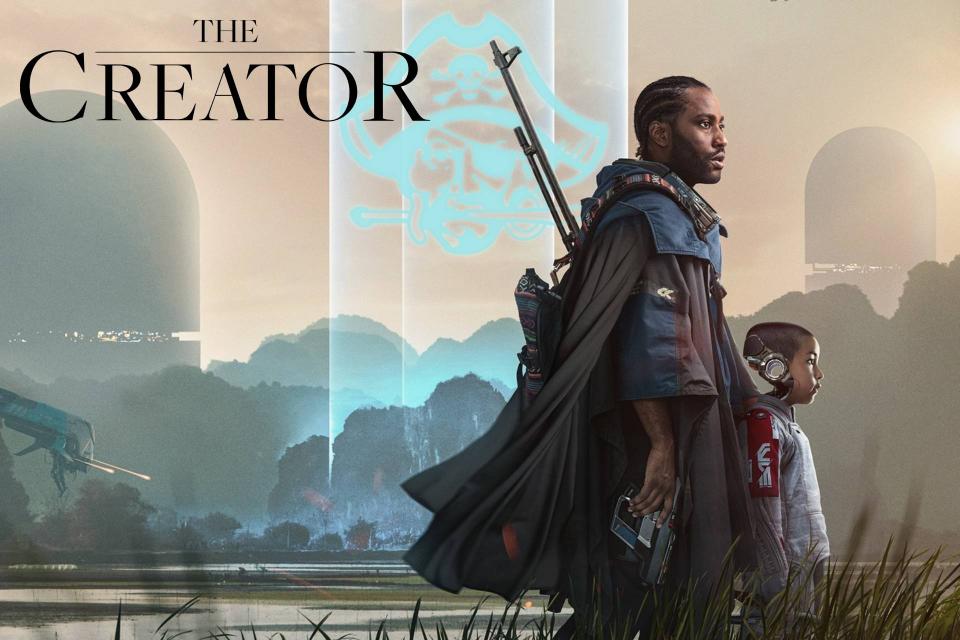Opinion: “The Creator”: stunning visuals can’t save a mediocre story
Filmmaker Gareth Edwards’s much-anticipated original sci-fi film “The Creator” was released in theaters on Sept. 30, 2023, and it failed to live up to the hype. This movie is disappointing because it feels as cookie-cutter and one-note as the typical blockbuster fare, despite it being one of the few sci-fi movies released in the past few years that is not attached to a series.
“The Creator” is set in the 2060s, in a world where humans, robots, and “simulants” (robots with human faces and bodies) exist together. In the United States, the simulants have been wiped out after some of them detonated a nuclear bomb in Los Angeles, California. However, in the Republic of Asia, humans and simulants coexist peacefully, causing the United States to take military action against the simulants living in Asia with its space station called the U.S.S. NOMAD.
The film follows a U.S. Army sergeant, Joshua Taylor (John David Washington), who attempts to track down his long-lost wife Maya with the help of a simulant named Alphie (Madeleine Yuna Voyles). Over the course of his journey with Alphie, who resembles a child, Joshua learns that the robots and simulants truly do live and feel, and ought to be treated the same as humans. At the end of the film, Joshua is motivated to take action against the U.S. government. Joshua and Alphie destroy the NOMAD in order to protect the simulants still living in Asia.
If I had to describe “The Creator” in a few words, I’d choose “identity crisis.” The film feels like it doesn’t know in which direction it’s going. One moment it’s a cute buddy road trip movie between Alphie and Joshua with incredibly weak attempts at humor, and the next it’s portraying a gruesome battlefield where innocent villages are being missile-striked.
Another example of the film being confused about its identity comes about 45 minutes in. While Alphie and Joshua are holed up in a house in Asia, they are surrounded by the local police. They fight police robots and at the end, no robots are left standing. Remember, one of the film’s messages is that the simulants and robots are full equals to the humans. If this is true, then a dozen people were just killed attempting to defend their homes. However, the film tries to take this as a comedic moment; lingering on a cartoonish shot of robot legs aimlessly wandering around, which contradicts the serious and intense atmosphere that existed moments before.
In addition to the tonal inconsistencies, the film also doesn’t have anything interesting to say. There’s no moral ambiguity to the conflict; the simulants and humans who stand with them are clearly morally right, and the U.S. Army is clearly in the wrong. When I first heard about this film, I thought that it would leave the questions it raises about humanity and sentience open-ended, but instead, it takes a clear stance, stating that the simulants are just as sentient as the humans.
Wooden dialogue, unfunny jokes, mediocre direction, and lifeless action all just lead to the feeling that this film died by a thousand cuts. I would be okay with a lot of these issues if they just existed on their own, but having all of them in the same film makes it largely an unenjoyable viewing experience.
Although I’ve been fairly critical of this film, I would like to end with something positive: the visuals. In an era of hugely overblown blockbuster budgets, what Gareth manages to do with a mere $80 million is nothing short of a miracle. The film’s futuristic locales always look real, and the action, while not mind-blowing, makes you feel immersed. For all its faults, this film is truly gorgeous, and I’m glad I saw it in a theater rather than on my phone.
However, the dazzling visual effects cannot save “The Creator” from the flaws present in its story. It’s not abhorrently awful, but all it delivers is a bland and cliché narrative, which leads me to give it a 2 out of a possible 5.5 on the “Zarro Scale.”

